#Masahira Fujiyasu
Explore tagged Tumblr posts
Text

A few days ago I had the amazing opportunity to meet, speak with, and watch the famous Japanese blacksmith Masahira Fujiyasu work during a special event at the Minka-en grounds in Fukushima City, thanks to the hard work and planning of Andy Coombs and the Fukushima City Tourism and Convention Association. This type of event hasn’t been held for over a decade and the majority of Japanese people never get this opportunity, let alone a foreigner. Mr. Fuhiyasu’s master was a national treasure of Japan and I am told that Mr. Fujiyasu is the last classically trained blacksmith that has mastered techniques of making Kamakura and Muromachi period styled blades. What added to this even more was the opportunity to speak with him and his students during lunch and while he was taking a break in the afternoon.
We arrived at the forge around 10am to find Mr. Fujiyasu finishing his preparations for the day. He made a forge and billows there just days before. It was interesting to see as it had two air inlets with flaps that would alternate as he pushed and pulled to create a constant stream of air to feed the hot coals, reaching temperatures of 2700 and above, depending on which stage he was at and how hot he wanted it to be.
Seeing as we only had about 6 hours for the event he decided to work on a few swords at different stages of the creation process to give a better understanding of the Japanese sword creation methodology. He had already prepared the tamagahane and placed it in a concise pile to be inserted into the hot coals.
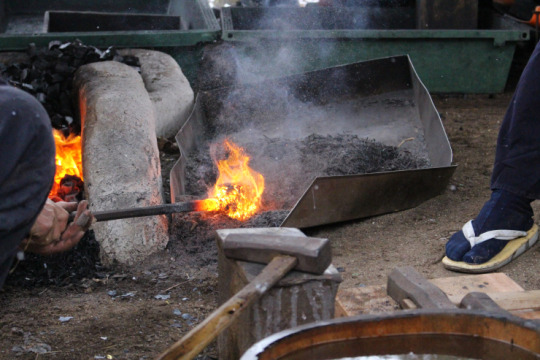
After removing the white-hot steel from the coals he would roll the block in a pile of ashes and quickly begin the hammering process.
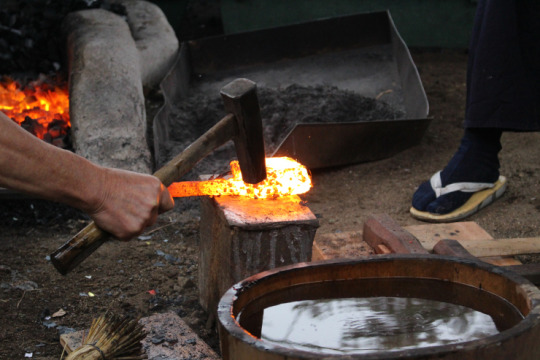
While he worked, one of his students would help hammer, while the other would quickly cut the charcoal into specific sized chunks, in order to maintain a consistent temperature. They would switch out once in a while, and during a certain stage they both worked to hammer at the same time.
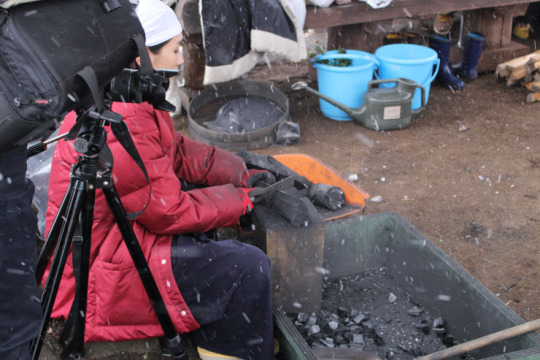
After a while Mr. Fujiyasu started folding the steel. He folded it not only in half vertically, but at least once horizontally as well. To do so he used a wedge to partially split the molten steel, then he would slowly hammer it as he rotated it on the anvil.
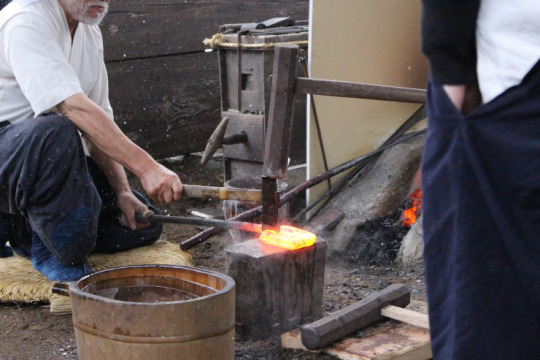
After several folds (and a few hours) everyone took a lunch break. We had some delicious hot Soba, Udon ,and onigiri as everyone relaxed in the warmth of the space heaters.
Here I was able to speak with Mr. Fujiyasu a bit and discovered that he was an avid Kyuudou practitioner and he felt that it was an important part of his life. We discussed martial arts, and the swords he would be working on for the rest of the day. He said he would be working on a kogatana (short sword) and a katana (long sword).
When he said “kogatana” I asked if that was the same as a wakizashi, or maybe a tanto. He said that in the time period he specializes in, they didn’t use the term wakizashi yet, so shorter swords are generally referred to as just kogatana. If the length was compared to modern standards, it would fall roughly into the size of a wakizashi, but on the long end. The katana he worked on was to be 2 shaku 4 sun in length.
Terms such as shaku (shah-ku), sun (soon), and bu (boo) are still used today to reference sword length. 1 shaku is about 30.3022 cm (or 11.9303 inches), while a sun is 1/10 that of a shaku (3.03022cm / 1.192999in), and a bu is 1/10 that of a sun (0.303022cm / 0.119299in). If discussing cloth length, the measurements change would slightly.
So the length of the katana he would be working on should be about 72.725cm (28.6319in) from the tip of the blade to where it meets the metal collar mounted between a sword blade and the hand guard (habaki). That’s about the same length as the blade that I use for Iaido training…so I was looking forward to seeing the outcome even more.
From here Mr. Fujiyasu skipped about 2 days of the folding process by taking out the blades discussed above, that he had worked on at his personal forge. The blocks had been formed into long rectangular rods

and he started to hammer them into his general desired shape. He would often splash water under the blade as he forged it, creating loud booming sounds as he struck.
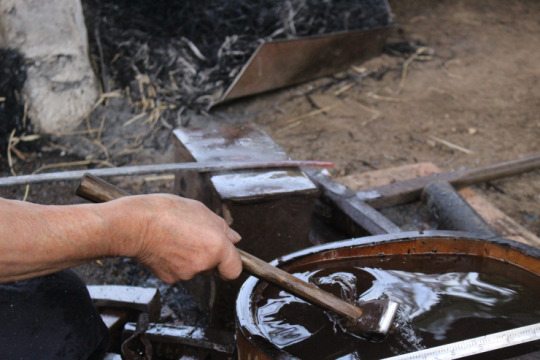
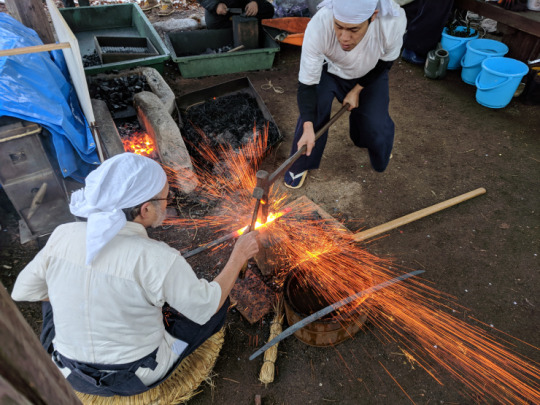
Here is the end product for this stage.

From here he would continue to work on the blade for several more steps, such as a rough shaping (7th step), cleaning with a slurry (8th), tempering with the slurry after being heated to the desired temperature (9th, often at night or in a fully enclosed and dark place to better see the color of the flame and sword). Here, Mr. Fujiyasu must decide whether the sword was a success or a failure. If it’s a failure, it will be scrapped and he will have to start the process over from the beginning. If not, he moves on to filing the blade to his desired thickness and to straightening any light bends in the blade. Then he will also use an arato whetstone (~200 grit), bringing the blade to what I am holding in the photo below. (some lovely hat hair included)

At this point Mr. Fujiyasu took a break between shaping the two swords and came over to speak with me about the katana I was inspecting. This is a sword that he had finished a few days earlier and we talked a lot about the shape as it had a strong curve for such a long sword. From our earlier conversation he knew that I practiced Iaido and asked me a few questions about the blade to see if I could guess the length, weight, and a few other aspects. It was almost exactly my size and he said I was right on the mark! We then discussed a few other details and what else was needed for the blade to be completed. For this one, it still needed to be handed off to a profession sword polisher and to have his name and place of creation inscribed into the tang. I was having a blast as he is a really energetic older gentleman. I hope I have the please of speaking with him again soon.
Unfortunately we couldn’t stay until the end as the group we were with was scheduled to leave, but we were showed around the Minka-en and saw a few of his completed works, some traditional buildings and workshops, and even an old theater with a massive rotating floor.
This was an absolutely amazing experience and this certainly doesn’t do it justice. In a week or so, I should have a video up here so you can see everyone in action as well. If I’m lucky, I might be able to order a custom made katana from him next year! That’s still a long way off and I would need to have in-depth talks with him as well as my sensei, but just the thought is enough to send me back to the dojo with even more energy than usual!
The event was covered by the prefectural news station (NHK TUF) and here is a short clip from that coverage (in Japanese starting at about 21:06).
Note: I am not a blacksmith and the entire event was conducted in Japanese with some interpretation services from Mr. Coombs. It is quite possible that I misheard some of the information and that could result in an incorrect use of terminology in this post. If you see something that should be corrected, please feel free to comment below in order to let me know.
*Thanks Tito for a few of the photos used above!
Making of the Katana: Behind the scenes with a Master A few days ago I had the amazing opportunity to meet, speak with, and watch the famous Japanese blacksmith…
#adventure#art#blacksmith#Business#cold#福島#design#Epic#鍛冶屋#famous#fire#forge#Fujiyasu#Fukushima#fun#Japan#karate#katana#kyudo#life#make#martial arts#Masahira Fujiyasu#master#me#metal#mindofrion#mindofryan#NHK#opinion
0 notes